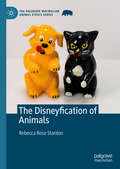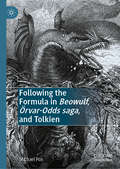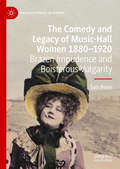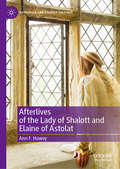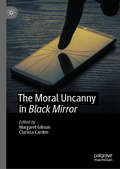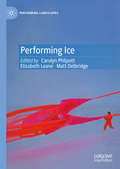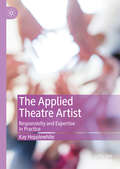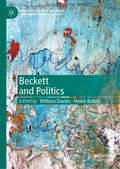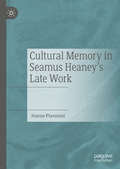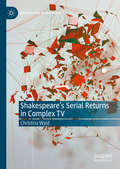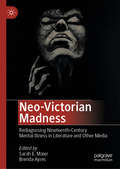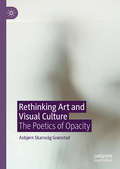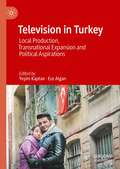- Table View
- List View
Derrida | Benjamin: Two Plays for the Stage
by John Schad Fred DalmassoWithin the work of both Jacques Derrida and Walter Benjamin there is a buried theatricality, a theatre to-come. And in the last fifteen years there has been a growing awareness of this theatricality. To date, though, there has not been a published stage play about either Derrida or BenjaminCue Derrida| Benjamin, a volume that brings together two tragi-comic plays which mirror each other in a host of ways – above all, in the way that the central philosophical figure is displaced, or not quite where or when we would expect to find them. In Derrida’s case, it is Oxford in 1968; in Benjamin’s case, it is somewhere (or nowhere) near London in 1948. These, then, are plays in which the philosopher is exiled, or elsewhere – not quite himself. This a volume for anyone with an eye or ear for where theatre or performance meets philosophy – students, scholars, readers, actors.
Chinese Urban Shi-nema: Cinematicity, Society and Millennial China
by David H. Fleming Simon HarrisonThis book dives into the mise-en-scène of contemporary China to explore the “becoming cinema” of Chinese cities, societies, and subjectivities. Set in the wake of China’s radical and rapid period of urbanization and infrastructural transformation, and situating itself in the processual city of Ningbo, the book combines empirical, ficto-critical, and philosophical methods to generate a dynamic account of everyday life as new forms of consumer culture bed in. Harnessing a Realist approach that allows for different scales of analysis, the book zooms in on five architectural assemblages including: surreal real estate showrooms; a fragmented history museum; China’s “first and best” Sino-foreign university; a new “Old town”; and weird gamified “any-now(here)-spaces.” Together these modern arrangements and machines for living cast light upon the broader picture sweeping up greater China.
The Disneyfication of Animals (The Palgrave Macmillan Animal Ethics Series)
by Rebecca Rose StantonThis book critically examines how Walt Disney Animation Studios has depicted – and sometimes failed to depict – different forms of harming and objectifying non-human animals in their films. Each chapter addresses a different form of animal harm and objectification through the theories of speciesism, romanticism, and the ‘collapse of compassion’ effect, from farming, hunting and fishing, to clothing, work, and entertainment. Stanton lucidly presents the dichotomy between depictions of higher order, anthropomorphised and neotonised animal characters and that of lower-order species, showing furthermore how these depictions are closely linked to changing social attitudes about acceptable forms of animal harm. An engaging and novel contribution to the field of Critical Animal Studies, this book explores the use of animals not only in Disney’s best known animated films such as 101 Dalmatians, but also lesser known features including Home on the Range and Fun and Fancy Free. A quantitative appendix supplying data on how often each animal species appears and the amount of times animal harm or objectification is depicted in over fifty films provides an invaluable resource and addition to scholars working in both Disney and animal studies.
Script Development: Critical Approaches, Creative Practices, International Perspectives
by Craig Batty Stayci TaylorThis book offers the first international look at how script development is theorised and practiced. Drawing on interviews, case studies, discourse analysis, creative practices and industry experiences, it brings together scholars and practitioners from around the world to offer critical insights into this core, but often hidden, aspect of screenwriting and screen production. Chapters speculate and reflect upon how creative, commercial and social practices – in which ideas, emotions, people and personalities combine, cohere and clash – are shaped by the practicalities, policies and rapid movements of the screen industry. Comprising two parts, the book first looks ‘into’ script development from a theoretical perspective, and second looks ‘out from’ the practice to form practitioner-led perspectives of script development. With a rising interest in screenwriting and production studies, and an increased appetite for practice-based research, the book offers a timely mapping of the terrain of script development, providing rich foundations for both study and practice.
Pedagogical Explorations in a Posthuman Age: Essays on Designer Capitalism, Eco-Aestheticism, and Visual and Popular Culture as West-East Meet (Palgrave Studies in Educational Futures)
by jan jagodzinskiThis book problematizes the role of education in an increasingly mediatized world through the lenses of creativity, new media, and consumerism. At the core of the issue, the author argues, creativity in art education is being co-opted to serve the purposes of current economic trends towards designer capitalism. Using an East meets West approach, jagodzinski draws on Deleuze and Guattarian philosophy to explore visual and popular culture in Korean society, addressing the tensions that exist between designer education and art that explores the human condition. In doing so, he challenges art educators to envision a new paradigm for education which questions established media ontologies and incorporates new ways to confront the crisis of the Anthropocene.
The Challenge of World Theatre History
by Steve TillisThe future of theatre history studies requires consideration of theatre as a global phenomenon. The Challenge of World Theatre History offers the first full-scale argument for abandoning an obsolete and parochial Eurocentric approach to theatre history in favor of a more global perspective. This book exposes the fallacies that reinforce the conventional approach and defends the global perspective against possible objections. It moves beyond the conventional nation-based geography of theatre in favor of a regional geography and develops a new way to demarcate the periods of theatre history. Finally, the book outlines a history that recognizes the often-connected developments in theatre across Eurasia and around the world. It makes the case that world theatre history is necessary not only for itself, but for the powerful comparative and contextual insights it offers to all theatre scholars and students, whatever their special areas of interest.
Following the Formula in Beowulf, Örvar-Odds saga, and Tolkien
by Michael FoxFollowing the Formula in Beowulf, Örvar-Odds saga, and Tolkien proposes that Beowulf was composed according to a formula. Michael Fox imagines the process that generated the poem and provides a model for reading it, extending this model to investigate formula in a half-line, a fitt, a digression, and a story-pattern or folktale, including the Old-Norse Icelandic Örvar-Odds saga. Fox also explores how J. R. R. Tolkien used the same formula to write Sellic Spell and The Hobbit. This investigation uncovers relationships between oral and literate composition, between mechanistic composition and author, and between listening and reading audiences, arguing for a contemporary relevance for Beowulf in thinking about the creative process.
Robert De Niro at Work: From Screenplay to Screen Performance (Palgrave Studies in Screenwriting)
by Adam Ganz Steven PriceRobert De Niro at Work is the first critical study to examine how Robert de Niro, perhaps the finest screen actor of his generation, works with screenplays to imagine, prepare and denote his performance. In categorising the various ways in which De Niro works with a screenplay, this book will re-examine the relationship between actor and text. This book considers the screenplay as above all a working document and a material object, present at every stage of the filmmaking process. The working screenplay goes through various iterations in development and exists in many versions on set, each adapted and personalised for the specific use of the individual and their role. As the archive reveals, nobody works more closely with the script than the actor, and no actor works more on a script than De Niro.
The Comedy and Legacy of Music-Hall Women 1880-1920: Brazen Impudence and Boisterous Vulgarity (Palgrave Studies in Comedy)
by Sam BealeThis book explores the comedy and legacy of women working as performers on the music-hall stage from 1880–1920, and examines the significance of their previously overlooked contributions to British comic traditions. Focusing on the under-researched female ‘serio-comic’, the study includes six micro-histories detailing the acts of Ada Lundberg, Bessie Bellwood, Maidie Scott, Vesta Victoria, Marie Lloyd and Nellie Wallace. Uniquely for women in the late-nineteenth and early-twentieth centuries, these pioneering performers had public voices. The extent to which their comedy challenged Victorian and Edwardian perceptions of women is revealed through explorations of how they connected with popular audiences while also avoiding censorship. Their use of techniques such as comic irony and stereotyping, self-deprecation, and comic innuendo are considered alongside the work of contemporary stand-up comedians and performance artists including Bridget Christie, Bryony Kimmings, Sara Pascoe, Shazia Mirza and Sarah Silverman.
Romance in Post-Socialist Chinese Television (East Asian Popular Culture)
by Huike WenThis book is about how the representations of romantic love in television reflect the change and the dilemma of the dominant values in post-socialist Chinese mainstream culture. These values mainly center on the impact of individualism, consumerism, capitalism, and neoliberalism, often referred to as western culture, on the perception of romantic love and self-realization in China.The book focuses on how romantic love, which plays a vital role in China’s ideologically highly restricted social environment by empowering people with individual choice, change, and social mobility, must struggle and compromise with the reality, specifically the values and problems emerging in a transitional China. The book also examines how the representation of romantic love celebrates ideals—individual freedom, passion, and gender equality—and promises changes based on individual diligence and talent while simultaneously obstructing the fulfillment of these ideals.
Afterlives of the Lady of Shalott and Elaine of Astolat (Arthurian and Courtly Cultures)
by Ann F. HoweyThis book investigates adaptations of The Lady of Shalott and Elaine of Astolat in Victorian and post-Victorian popular culture to explore their engagement with medievalism, social constructions of gender, and representations of the role of art in society. Although the figure of Elaine first appeared in medieval texts, including Malory’s Le Morte Darthur, Tennyson’s poems about the Lady and Elaine drew unprecedented response from musicians, artists, and other authors, whose adaptations in some cases inspired further adaptations. With chapters on music, art, and literature (including parody, young people’s literature, and historical fiction and fantasy), this book seeks to trace the evolution of these characters and the ways in which they reinforce or challenge conventional gender roles, represent the present’s relationship to the past, and highlight the power of art.
The Moral Uncanny in Black Mirror
by Margaret Gibson Clarissa CardenThis erudite volume examines the moral universe of the hit Netflix show Black Mirror. It brings together scholars in media studies, cultural studies, anthropology, literature, philosophy, psychology, theatre and game studies to analyse the significance and reverberations of Charlie Brooker’s dystopian universe with our present-day technologically mediated life world. Brooker’s ground-breaking Black Mirror anthology generates often disturbing and sometimes amusing future imaginaries of the dark side of ubiquitous screen life, as it unleashes the power of the uncanny. This book takes the psychoanalytic idea of the uncanny into a moral framework befitting Black Mirror’s dystopian visions. The volume suggests that the Black Mirror anthology doesn’t just make the viewer feel, on the surface, a strange recognition of closeness to some of its dystopian scenarios, but also makes us realise how very fragile, wavering, fractured, and uncertain is the human moral compass.
Memory and Intermediality in Artists’ Moving Image (Experimental Film and Artists’ Moving Image)
by Sarah DurcanThis book addresses the preoccupation with memory in contemporary artists’ moving image installations. It situates artists’ moving image in relation to the transformations of digitalization as hybrid intermedial combinations of analogue film, video and digital video emerge from mid 1990s onwards. While film has always been closely associated with the process of memory, this book investigates new models of memory in artists’ remediation of film with video and other intermedial aesthetics. Beginning with a chapter on the theorization of memory and the moving image and the diverse genealogies of artists’ film and video, the following chapters identify five different mnemonic modes in artists’ moving image: critical nostalgia, database narrative, the ‘echo-chamber’, documentary fiction and mediatized memories. Stan Douglas, Steve McQueen, Runa Islam, Mark Leckey and Elizabeth Price are of a generation that has lived through the transition from analogue to digital. Their emphasis on the nuances of intermediality indicates the extent to which we remember through media.
Performing Ice (Performing Landscapes)
by Elizabeth Leane Matt Delbridge Carolyn PhilpottIn the Anthropocene, icy environments have taken on a new centrality and emotional valency. This book examines the diverse ways in which ice and humans have performed with and alongside each other over the last few centuries, so as to better understand our entangled futures. Icescapes – glaciers, bergs, floes, ice shelves – are places of paradox. Solid and weighty, they are nonetheless always on the move, unstable, untrustworthy, liable to collapse, overturn, or melt. Icescapes have featured – indeed, starred – in conventional theatrical performances since at least the eighteenth century. More recently, the performing arts – site-specific or otherwise – have provoked a different set of considerations of human interactions with these non-human objects, particularly as concerns over anthropogenic warming have mounted. The performances analysed in the book range from the theatrical to the everyday, from the historical to the contemporary, from low-latitude events in interior spaces to embodied encounters with the frozen environment.
Gender, Media and Voice: Communicative Injustice and Public Speech
by Jilly Boyce KayThis book explores the increasing imperatives to speak up, to speak out, and to ‘find one’s voice’ in contemporary media culture. It considers how, for women in particular, this seems to constitute a radical break with the historical idealization of silence and demureness. However, the author argues that there is a growing and pernicious gap between the seductive promise of voice, and voice as it actually exists. While brutal instruments such as the ducking stool and scold’s bridle are no longer in use to punish women’s speech, Kay proposes that communicative injustice now operates in much more insidious ways. The wide-ranging chapters explore the mediated ‘voices’ of women such as Monica Lewinsky, Hannah Gadsby, Diane Abbott, and Yassmin Abdel-Magied, as well as the problems and possibilities of gossip, nagging, and the ‘traumatised voice’ in television talk shows. It critiques the optimistic claims about the ‘unleashing’ of women’s voices post-#MeToo and examines the ways that women’s speech continues to be trivialized and devalued. Communicative justice, the author argues, is not about empowering individuals to ‘find their voice’, but about collectively transforming the whole communicative terrain.
The Applied Theatre Artist: Responsivity and Expertise in Practice
by Kay HepplewhiteThis book analyses the work of applied theatre practitioners using a new framework of ‘responsivity’ to make visible their unique expertise. In-depth investigation of practice combines with theorisation to provide a fresh view of the work of artists and facilitators. Case studies are drawn from community contexts: with women, mental health service users, refugees, adults with a learning disability, older people in care, and young people in school. Common skills and qualities are given a vocabulary to help define applied theatre work, such as awareness, anticipation, adaptation, attunement, and responsiveness. The Applied Theatre Artist is of scholarly, practical, and educational interest. The book offers detailed analysis of how skilled theatre artists make in-action decisions within socially engaged participatory projects. Rich description of in-session activity reveals what workshop facilitators actually do and how they think, offering a rare focus in applied theatre.
Beckett and Politics: Politics, Propaganda And A 'universe Become Provisional' (New Directions in Irish and Irish American Literature)
by William Davies Helen BaileyThis collection of essays reveals the extent to which politics is fundamental to our understanding of Samuel Beckett’s life and writing. Bringing together internationally established and emerging scholars, Beckett and Politics considers Beckett’s work as it relates to three broad areas of political discourse: language politics, biopolitics and geopolitics. Through a range of critical approaches, including performance studies, political theory, gender theory, historicizing approaches and language theory, the book demonstrates how politics is more than just another thematic lens: it is fundamentally and structurally intrinsic to Beckett’s life, his texts and subsequent interpretations of them. This important collection of essays demonstrates that Beckett’s work is not only ripe for political engagement, but also contains significant opportunities for understanding and illuminating the broader relationships between literature, culture and politics.
Cultural Memory in Seamus Heaney’s Late Work
by Joanne PiavaniniCultural Memory in Seamus Heaney’s Late Work considers the ways that memory functions in Heaney’s poetry. Joanne Piavanini argues that the shaping of collective memory is one of Heaney’s major contributions as a poet. Locating Heaney in a transnational literary sphere, this book argues that his late work isdefined by a type of cosmopolitanism openness: the work moves beyond national identity to explore multiple allegiances and identifications. Moreover, Piavanini demonstrates that memory is a helpful lens to look at Heaney’s late work, in particular, because of the interplay of past, present and future in these works: in the construction of a collective memory of the Troubles; in the use of the elegy to commemorate the passing of important contemporary poets; in his writing on events with transnational significance, such as 9/11; in the slippages between past and present in poems about his family; and through the literary afterlives of texts—specifically, his appropriation of canonical classical texts. Drawing on approaches and concepts from memory studies, Piavanini considers Heaney’s late work to develop an analysis of poetry as a vehicle of memory.
Shakespeare’s Serial Returns in Complex TV (Reproducing Shakespeare)
by Christina WaldThis book examines how Shakespeare’s plays resurface in current complex TV series. Its four case studies bring together The Tempest and the science fiction-Western Westworld, King Lear and the satirical dynastic drama of Succession, Hamlet and the legal thriller Black Earth Rising, as well as Coriolanus and the political thriller Homeland. The comparative readings ask what new insights the twenty-first-century remediations may grant us into Shakespeare’s texts and, vice versa, how Shakespearean returns help us understand topical concerns negotiated in the series, such as artificial intelligence, the safeguarding of democracy, terrorism, and postcolonial justice. This study also proposes that the dramaturgical seriality typical of complex TV allows insights into the seriality Shakespeare employed in structuring his plays. Discussing a broad spectrum of adaptational constellations and establishing key characteristics of the new adaptational aggregate of serial Shakespeare, it seeks to initiate a dialogue between Shakespeare studies, adaptation studies, and TV studies.
Neo-Victorian Madness: Rediagnosing Nineteenth-Century Mental Illness in Literature and Other Media
by Sarah E. Maier Brenda AyresNeo-Victorian Madness: Rediagnosing Nineteenth-Century Mental Illness in Literature and Other Media investigates contemporary fiction, cinema and television shows set in the Victorian period that depict mad murderers, lunatic doctors, social dis/ease and madhouses as if many Victorians were “mad.” Such portraits demand a “rediagnosing” of mental illness that was often reduced to only female hysteria or a general malaise in nineteenth-century renditions. This collection of essays explores questions of neo-Victorian representations of moral insanity, mental illness, disturbed psyches or non-normative imaginings as well as considers the important issues of legal righteousness, social responsibility or methods of restraint and corrupt incarcerations. The chapters investigate the self-conscious re-visions, legacies and lessons of nineteenth-century discourses of madness and/or those persons presumed mad rediagnosed by present-day (neo-Victorian) representations informed by post-nineteenth-century psychological insights.
Staging the Personal: A Guide to Safe and Ethical Practice
by Clark BaimThis book examines the history, ethics, and intentions of staging personal stories and offers theatre makers detailed guidance and a practical model to support safe, ethical practice. Contemporary theatre has crossed boldly into therapeutic terrain and is now the site of radical self-exposure. Performances that would once have seemed shockingly personal and exposing have become commonplace, as people reveal their personal stories to audiences with ever-increasing candor. This has prompted the need for a robust and pragmatic framework for safe, ethical practice in mainstream and applied theatre. In order to promote a wider range of ethical risk-taking where practitioners negotiate blurred boundaries in safe and artistically creative ways, this book draws on relevant theory and practice from theatre and performance studies, psychodrama and attachment narrative therapy and provides detailed guidance supporting best practice in the theatre of personal stories. The guidance is structured within a four-part framework focused on history, ethics, praxis, and intentions. This includes a newly developed model for safe practice, called the Drama Spiral.The book is for theatre makers in mainstream and applied theatre, educators, students, researchers, drama therapists, psychodramatists, autobiographical performers, and the people who support them.
Dance in Contested Land: New Intercultural Dramaturgies (New World Choreographies)
by Rachael SwainThis book traces an engagement between intercultural dance company Marrugeku and unceded lands of the Yawuru, Bunuba, and Nyikina in the north west of Australia. In the face of colonial legacies and extractive capitalism, it examines how Indigenous ontologies bring ecological thought to dance through an entangled web of attachments to people, species, geologies, political histories, and land. Following choreographic interactions across the multiple subject positions of Indigenous, settler, and European artists between 2012–2016 the book closely examines projects such as Yawuru/Bardi dancer and choreographer Dalisa Pigram’s solo Gudirr Gudirr (2013) and the multimedia work Cut the Sky (2015). Dance in Contested Land reveals how emergent intercultural dramaturgies can mediate dance and land to revision and reorientate kinetics, emotion, and responsibilities through sites of Indigenous resurgence and experimentation.
Dementia, Narrative and Performance: Staging Reality, Reimagining Identities
by Janet GibsonFocusing mainly on case studies from Australia and the United States of America, this book considers how people with dementia represent themselves and are represented in ‘theatre of the real’ productions and care home interventions, assessing the extent to which the ‘right kind’ of dementia story is being affirmed or challenged. It argues that this type of story — one of tragedy, loss of personhood, biomedical deficit, and socio-economic ‘crisis — produces dementia and the people living with it, as much as biology does. It proposes two novel ideas. One is that the ‘gaze’ of theatre and performance offers a reframing of some of the behaviours and actions of people with dementia, through which deficit views can be changed to ones of possibility. The other is that, conversely, dementia offers productive perspectives on ’theatre of the real’. Scanning contemporary critical studies about and practices of ‘theatre of the real’ performances and applied theatre interventions, the book probes what it means when certain ‘theatre of the real’ practices (specifically verbatim and autobiographical) interact with storytellers considered, culturally, to be ‘unreliable narrators’. It also explores whether autobiographical theatre is useful in reinforcing a sense of ‘self’ for those deemed no longer to have one. With a focus on the relationship between stories and selves, the book investigates how selves might be rethought so that they are not contingent on the production of lucid self-narratives, consistent language, and truthful memories.
Rethinking Art and Visual Culture: The Poetics of Opacity
by Asbjørn Skarsvåg GrønstadThis is the first book to offer a systematic account of the concept of opacity in the aesthetic field. Engaging with works by Ernie Gehr, John Akomfrah, Matt Saunders, David Lynch, Trevor Paglen, Zach Blas, and Low, the study considers the cultural, epistemological, and ethical values of images and sounds that are fuzzy, indeterminate, distorted, degraded, or otherwise indistinct. Rethinking Art and Visual Culture shows how opaque forms of art address problems of mediation, knowledge, and information. It also intervenes in current debates about new systems of visibility and surveillance by explaining how indefinite art provides a critique of the positivist drive behind these regimes. A timely contribution to media theory, cinema studies, American studies, and aesthetics, the book presents a novel and extensive analysis of the politics of transparency.
Television in Turkey: Local Production, Transnational Expansion and Political Aspirations
by Yeşim Kaptan Ece AlganThis edited collection takes a timely and comprehensive approach to understanding Turkey’s television, which has become a global growth industry in the last decade, by reconsidering its geopolitics within both national and transnational contexts. The Turkish television industry along with audiences and content are contextualised within the socio-cultural and historical developments of global neoliberalism, transnational flows, the rise of authoritarianism, nationalism, and Islamism. Moving away from Anglo-American perspectives, the book analyzes both local and global processes of television production and consumption while taking into consideration the dynamics distinctive to Turkey, such as ethnic and gender identity politics, media policies and regulations, and rising nationalistic sentiments.


